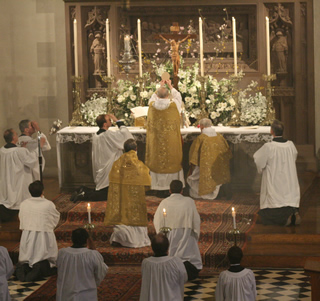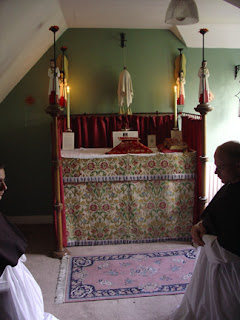Fr. Bartus recently wrote about the importance of the English
Baroque style of liturgics in Anglo-Catholicism and Ordinariate worship. To many traditionally minded Catholics this
liturgy looks a lot like the Extraordinary Form and they wonder what place it
has in the Ordinariate. As Fr. Bartus
pointed out, this liturgical style is a legitimate form of Anglican Patrimony,
celebrated and loved by many of the men and women who paved the way for Ordinariate.
I, however, would consider myself part of the Gothic or "English
Use" Anglo-Catholic tradition that relied heavily on the traditions of the
Sarum Use liturgy used until the middle of Edward VI's reign when the Book of
Common Prayer replaced it in 1549. I prefer a simple(r) altar with two candles and
bright colors and fabrics surrounding it.
I prefer gothic vestments over roman (fiddlebacks). I am more interested in what the Sarum missal
has to say about the music and proper liturgies of feast days than the
Tridentine Missal.
Yet, despite this preference, I have a background in the English
Baroque Anglo-Catholic liturgy. The
parish that played a large part of my formation in seminary was The Church of
the Ascension and St. Agnes in Washington D.C.
This parish used the Anglican Missal, which borrowed heavily from the
Roman Missal as it stood before the Holy Week reforms. Our vestments were made in France and you
could tell that by looking at them. We referred
to either Ritual Notes or Fortesue's Ceremonies of the Roman Rite Described
more than any ancient English manual.
 |
| ASA on Easter Sunday |
Yet despite (or perhaps because of) this mixed background I
emerged as an Ordinariate priest just as comfortable with the English Baroque
liturgics as with the "English Use" style. My love of the Eastern liturgies has only
grown with time and I was blessed to be able to concelebrate the Liturgy of St.
John Chrysostom at a Ruthenian parish on my third Sunday as a Catholic priest.
Given the prevalence of the English Baroque style in the Ordinariate,
I have made a conscious attempt to preserve the "English Use" in my
Ordinariate community along with many of the distinctive "low church"
elements of the Anglican Patrimony such as tippets and academic hoods. You will, however, find elements of the
Baroque in our worship. I have plenty of
fiddlebacks, because on a limited budget you can get traditional looking fiddlebacks
with ancient symbols or some pretty ugly
gothic chasubles. I have altar cards
because I need all the help I can get keeping the words straight switching
between the Book of Divine Worship and the Roman Missal on a daily basis.
We are at work on building up our chapel. We look like this now:
 |
| St. Gregory the Great Ordinariate Chapel on Christmas Eve |
but we are on our way towards making the altar look like this:
We will be one of the few "English Use" groups
around, but that doesn't make us the most Anglican of the Ordinariate parishes,
it just means we are a different side of the same coin that was the Catholic revival
in Anglicanism.



